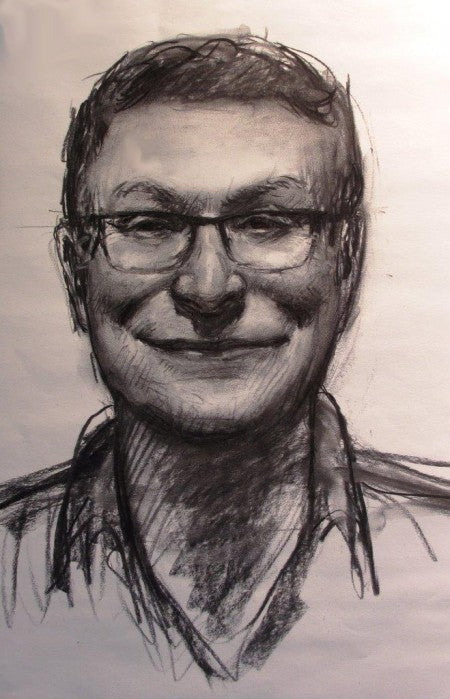The Charcoal Techniques of Gary Faigin

Faigin - (2014) Self Portrait. Charcoal on Bond.
Faigin’s teaching skills are highly admired by all those who would want to learn the draw the face and to be able to capture facial features and characteristic expressions. His book, The Artist's Complete Guide to Facial Expression has been a mainstay of the animation industry and used as a basic reference text for movies such as Shrek. In the course Drawing Facial Features, Faigin has shown that drawing portraits and capturing expression is more effectively learned when students view the whole structure of the form rather than seeing parts of the face in isolation.
The important thing to remember is that the skull is responsible for most of our appearance, which is why reconstruction artists can figure out what someone looked like if all they have to go on is the bones. Getting a likeness is a matter of size, placement, and proportion, and all of that comes from the structure, not the individual elements. I never draw or paint a face without imagining the bones underneath. (Faigin 2014)
You will see from the sensitive, expressive self-portrait above that Faigin is a master of the charcoal medium. His use of the material is soft, yet powerful and sculpturally expressive. Faigin stresses that students should be drawing life size portraits on Bond paper with charcoal. He recommends Bond paper so that the surface texture of the paper allows for the slipping and sliding and rubbing that he demonstrates throughout the course. He shows that charcoal is a forgiving medium able to be used rapidly and fluidly as he pushes the dust around the page. By rubbing with the hand and fingers, kneaded erasers and a chamois (soft leather rag)he is able to lift the charcoal off the page revealing highlights and sculptural forms.
The course is a series of focused demonstrations. They work systematically from an exploration of the skull, through an investigation of the parts of the face culminating as the forms become more refined and the surface of the face is modeled, capturing facial expression. Occasionally Faigin uses white chalk to capture intense highlights, but for the most part he works and reworks the surface to capture his subject’s form.
Drawing Facial Features
As Faigin explores the skull, he focuses on the overall skeletal structure, as it dictates the shape of the facial features. He also uses memoriable imagery to help students build up the form of the human head in their mind.
He likens the top section of the skull to an old-fashioned toaster and the bottom section of the skull to a wedge. Once he has described a section of the lower skull as a ‘sardine can’ the relationship of the parts to each other are firmly set in the mind. Thinking about drawing in this way brings immediate results and improvements. Faigin builds up a picture of how the parts of the skull fit together and then how features such as the eye fit neatly inside or onto this structure. The student comes away from the course with a clear approach to capturing form and with some rules and measurements that can be used to ensure that all parts of the drawing remain in proportion as the drawing emerges from the page.
Charcoal is the chosen medium for the entire course because it provides such ease of manipulation. No other drawing medium can compete with charcoal’s capacity to quickly and dramaticallymodel light and shade.

Faigin on the set of Drawing Facial Features. (2014)
The course is essentially about realizing underlying structures by manipulating the power of light to capture sculptural form. Faigin demonstrates how to set up the model with strong directional lighting that floods the figure, creating high contrast. This assists the student to really get down to the basics of seeing form. Viewed in this way, the underlying structure of the skeleton will always be thrown into high contrast and remain uppermost in the artists “minds eye”.
Faigin points out that it is not enough to be mindful of the structure of the skull but that it is also essential to be aware of and to capture the way the skull sits forward onto the neck and how this relates to the shoulders.
I recommend this course to students who wish to master the art of portraiture. Faigin suggests that if this is your aim, it makes sense to set up a mirror so that you can draw regular self-portraits. This will provide ease of access and a sense of familiarity and continuity.
